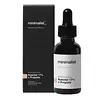What's inside
What's inside
 Key Ingredients
Key Ingredients

 Benefits
Benefits

 Concerns
Concerns

No concerns
 Ingredients Side-by-side
Ingredients Side-by-side

Water
Skin ConditioningPotassium Azeloyl Diglycinate
Skin ConditioningPropanediol
SolventGlycerin
HumectantPropolis Extract
Skin ConditioningPseudoalteromonas Ferment Extract
HumectantXylitylglucoside
HumectantAnhydroxylitol
HumectantXylitol
HumectantDimethyl Isosorbide
SolventDipotassium Glycyrrhizate
HumectantGallic Acid
AntioxidantSodium Hyaluronate
HumectantHydroxyethylcellulose
Emulsion StabilisingXanthan Gum
EmulsifyingLecithin
EmollientPhenoxyethanol
PreservativeEthylhexylglycerin
Skin ConditioningSclerotium Gum
Emulsion StabilisingPullulan
Trisodium Ethylenediamine Disuccinate
Lactic Acid
BufferingWater, Potassium Azeloyl Diglycinate, Propanediol, Glycerin, Propolis Extract, Pseudoalteromonas Ferment Extract, Xylitylglucoside, Anhydroxylitol, Xylitol, Dimethyl Isosorbide, Dipotassium Glycyrrhizate, Gallic Acid, Sodium Hyaluronate, Hydroxyethylcellulose, Xanthan Gum, Lecithin, Phenoxyethanol, Ethylhexylglycerin, Sclerotium Gum, Pullulan, Trisodium Ethylenediamine Disuccinate, Lactic Acid
Water
Skin ConditioningAloe Barbadensis Leaf Juice
Skin ConditioningPropylene Glycol
HumectantAzelaic Acid
BufferingBetaine
HumectantZinc PCA
HumectantBiosaccharide Gum-1
HumectantGlycerin
HumectantTriticum Aestivum Seed Extract
PerfumingTriticum Turgidum Durum Seed Extract
Skin ConditioningEragrostis Tef Seed Extract
EmollientChenopodium Quinoa Seed Extract
Skin ConditioningXanthan Gum
EmulsifyingSodium Levulinate
Skin ConditioningGlyceryl Caprylate
EmollientSodium Anisate
AntimicrobialCaprylyl Glycol
EmollientSodium Gluconate
Skin ConditioningBenzyl Alcohol
PerfumingDehydroacetic Acid
PreservativeSodium Benzoate
MaskingPhenoxyethanol
PreservativeSodium Hydroxide
BufferingCitric Acid
BufferingWater, Aloe Barbadensis Leaf Juice, Propylene Glycol, Azelaic Acid, Betaine, Zinc PCA, Biosaccharide Gum-1, Glycerin, Triticum Aestivum Seed Extract, Triticum Turgidum Durum Seed Extract, Eragrostis Tef Seed Extract, Chenopodium Quinoa Seed Extract, Xanthan Gum, Sodium Levulinate, Glyceryl Caprylate, Sodium Anisate, Caprylyl Glycol, Sodium Gluconate, Benzyl Alcohol, Dehydroacetic Acid, Sodium Benzoate, Phenoxyethanol, Sodium Hydroxide, Citric Acid
 Reviews
Reviews

Ingredients Explained
These ingredients are found in both products.
Ingredients higher up in an ingredient list are typically present in a larger amount.
Glycerin is already naturally found in your skin. It helps moisturize and protect your skin.
A study from 2016 found glycerin to be more effective as a humectant than AHAs and hyaluronic acid.
As a humectant, it helps the skin stay hydrated by pulling moisture to your skin. The low molecular weight of glycerin allows it to pull moisture into the deeper layers of your skin.
Hydrated skin improves your skin barrier; Your skin barrier helps protect against irritants and bacteria.
Glycerin has also been found to have antimicrobial and antiviral properties. Due to these properties, glycerin is often used in wound and burn treatments.
In cosmetics, glycerin is usually derived from plants such as soybean or palm. However, it can also be sourced from animals, such as tallow or animal fat.
This ingredient is organic, colorless, odorless, and non-toxic.
Glycerin is the name for this ingredient in American English. British English uses Glycerol/Glycerine.
Learn more about GlycerinPhenoxyethanol is a preservative that has germicide, antimicrobial, and aromatic properties. Studies show that phenoxyethanol can prevent microbial growth. By itself, it has a scent that is similar to that of a rose.
It's often used in formulations along with Caprylyl Glycol to preserve the shelf life of products.
Water. It's the most common cosmetic ingredient of all. You'll usually see it at the top of ingredient lists, meaning that it makes up the largest part of the product.
So why is it so popular? Water most often acts as a solvent - this means that it helps dissolve other ingredients into the formulation.
You'll also recognize water as that liquid we all need to stay alive. If you see this, drink a glass of water. Stay hydrated!
Learn more about WaterXanthan gum is used as a stabilizer and thickener within cosmetic products. It helps give products a sticky, thick feeling - preventing them from being too runny.
On the technical side of things, xanthan gum is a polysaccharide - a combination consisting of multiple sugar molecules bonded together.
Xanthan gum is a pretty common and great ingredient. It is a natural, non-toxic, non-irritating ingredient that is also commonly used in food products.
Learn more about Xanthan Gum